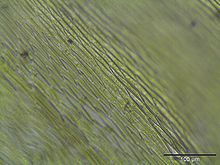Mauer-Schnabeldeckelmoos
| Mauer-Schnabeldeckelmoos | ||||||||||||
|---|---|---|---|---|---|---|---|---|---|---|---|---|

Mauer-Schnabeldeckelmoos ( Rhynchostegium murale ) |
||||||||||||
| Systematics | ||||||||||||
|
||||||||||||
| Scientific name | ||||||||||||
| Rhynchostegium murale | ||||||||||||
| ( Hedw. ) Chimp. |
The Mauer-Schnabeldeckelmoos ( Rhynchostegium murale ) is a pioneering, weakly competitive, quite common ( epiphytic ) deciduous moss from the Brachytheciaceae family that grows on other plants .
Identifying features
The Mauer-Schnabeldeckelmoos forms moist, shiny, strong, dense, fresh green to dark yellow-green, flat lawns. The creeping stems are branched and about 3 to 4 cm long. The branches are often kitten-shaped and mostly upright. The stem and branch leaves are of the same shape. They are about 1 to 1.4 mm long, are dry roof tiles or protruding upright. Their spoon-shaped, hollow shape is characteristic. The tip of the leaf is broadly rounded and has a short, attached tip. The poorly developed midrib disappears in the middle of the leaf. The slightly prosenchymatic lamina cells are elongated rhomboid and about 60 to 95 µm long and 7 to 10 µm wide. The rectangular leaf base cells are about 20 to 40 µm long and wider than the middle lamina cells. Spore ripening often takes place in late summer or in the winter months. The smooth capsule stem ( seta ) carries a slightly inclined, curved spore capsule that is slightly narrowed under the mouth, the lid of which is long and crooked and the kalyptra is cap-shaped. The spores are approximately 14 to 18 µm in diameter.
Occurrence
The pioneering, weakly competitive, quite frequent rock moss colonizes lime or base-rich, partially shaded to shady, fresh to moist, nutrient-rich locations. It is mostly found epiphytic on rock and on walls, less often in forests on bark near depressions or streams. It can also endure intermittent flooding and is rarely found on earth near rivers. Accompanying mosses are z. B. Didymon fallax , Fissidens taxifolius , or Plagiomnium rostratum . It is mainly widespread throughout Europe as far as East Asia and North Africa.
literature
- Martin Nebel, Georg Philippi (ed.): The mosses of Baden-Württemberg. Volume 2: Special part, (Bryophytina II, Schistostegales to Hypnobryales). Ulmer, Stuttgart 2001, ISBN 3-8001-3530-2 .
- Jan-Peter Frahm , Wolfgang Frey : Moosflora (= UTB . 1250). 4th, revised and expanded edition. Ulmer, Stuttgart 2004, ISBN 3-8252-1250-5 .

